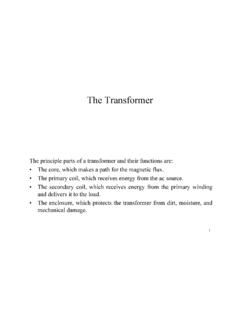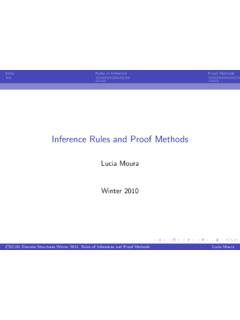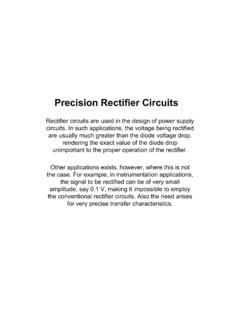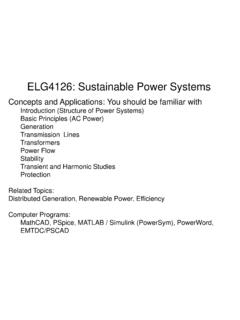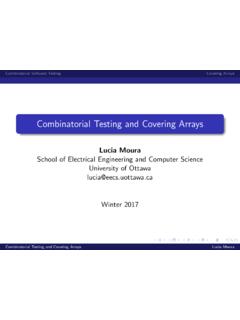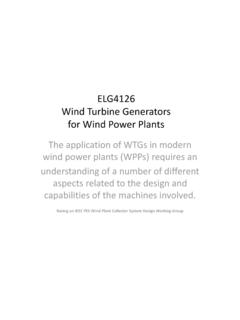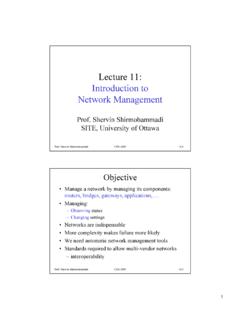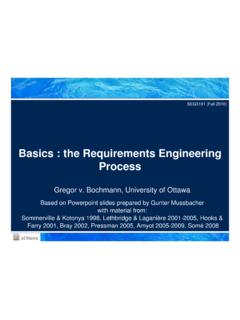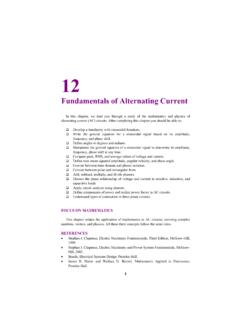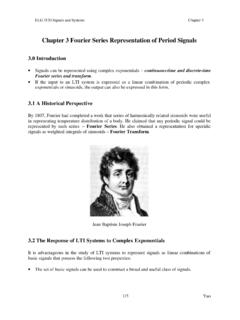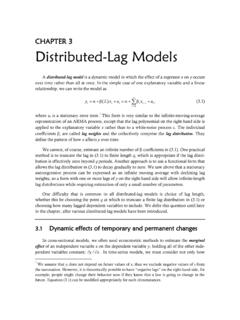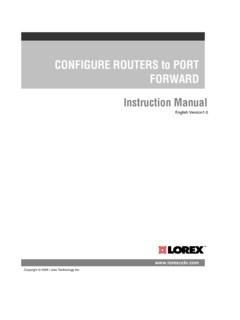Transcription of Chapter 3 State Variable Models - Engineering
1 1 Chapter 3 State Variable ModelsThe State Variables of a Dynamic SystemThe State Differential EquationSignal-Flow Graph State VariablesThe Transfer Function from the State Equation2 Introduction In the previous Chapter , we used Laplace transform to obtain the transfer function Models representing linear, time-invariant, physical systems utilizing block diagrams to interconnect systems. In Chapter 3, we turn to an alternative method of system modeling using time-domain methods. In Chapter 3, we will consider physical systems described by an nth-order ordinary differential equations. Utilizing a set of variables known as State variables, we can obtain a set of first-order differential equations. The time-domain State Variable model lends itself easily to computer solution and Control System With the ready availability of digital computers, it is convenient to consider the time-domain formulation of the equations representing control systems.
2 The time-domain is the mathematical domain that incorporates the response and description of a system in terms of time t. The time-domain techniques can be utilized for nonlinear, time-varying, and multivariable systems (a system with several input and output signals). A time-varying control system is a system for which one or more of the parameters of the system may vary as a function of time. For example, the mass of a missile varies as a function of time as the fuel is expended during flight4 Terms State :The State of a dynamic system is the smallest set of variables (called State variables) so that the knowledge of these variables at t= t0, together with the knowledge of the input for t t0, determines the behavior of the system for any time t t0. State Variables:The State variables of a dynamic system are the variables making up the smallest set of variables that determine the State of the dynamic system.
3 State Vector:If nstate variables are needed to describe the behavior of a given system, then the nstate variables can be considered the ncomponents of a vector x. Such vector is called a State vector. State Space:The n-dimensional space whose coordinates axes consist of the x1axis, x2axis, .., xnaxis, where x1, x2, .., xnare State variables, is called a State space. State -Space Equations:In State -space analysis, we are concerned with three types of variables that are involved in the modeling of dynamic system: input variables, output variables, and State State Variables of a Dynamic System The State of a system is a set of variables such that the knowledge of these variables and the input functions will, with the equations describing the dynamics, provide the future State and output of the system.
4 For a dynamic system, the State of a system is described in terms of a set of State (t)u2(t)y1(t)y2(t)Input SignalsOutput Signals6 State Variables of a Dynamic SystemDynamic SystemState x(t)u(t) Inputy(t) Outputx(0) initial conditiondynamics thedescribing equations theand inputs, excitation thestate,present given the system, a of response future thedescribe variablesstate The7 The State Differential EquationThe State of a system is described by the set of first-order differential equations written in terms of the State variables (x1, x2, .., xn)equation) aldifferenti (StateBu Axx.+=signals)output -equation(Output Du Cxy+=matrix nsmission direct tra :D matrix;Output :Cmatrixinput :B matrix; State :A + = ++++++=++++++=++++++= .. Budtdxx=&8 Block Diagram of the Linear, Continuous Time Control System)( (t) dtC(t)D(t)u(t)y(t)A(t))(u )D()( x)C()()(u )B()x(t)A()( +=+=++++x(t)9 Mass Grounded, M(kg)Mechanical system described by the first-order differential equationFa(t)x (t) ===ttaadttFMtvdttxdMdtdvMtFtxtvtT0)(1)() ()((m) )(position Linear (m/sec) )(ocity Linear velm)-(N )( torqueAppied22av (t)M10 Mechanical Example: Mass-Spring DamperA set of State variables sufficient to describe this system includes the position and the velocity of the mass, therefore, we will define a set of State variables as (x1, x2)uMxMkxmbdtdxxdtdxtukxbxdtdxMtukydtdyb dtydMdttdytxtytx1 ;)()()()()()(122211222221+ ===++=++==MKbWall frictiony(t)u(t)constant Spring :k11 Example 1:Consider the previous mechanical system.
5 Assume that the system is linear. The external force u(t) is the input to the system, and the displacement y(t) of the mass is the output. The displacement y(t) is measured from the equilibrium position in the absence of the external force. This system is a single-input-single-output system.[][]0 ,0 1C ,10B ,- -1 0 AuCxy ;BAxx:form standard in the areequation output theandequation State TheEquation)(Output 0 1 Equation) ( State 1021 mb- mk-1 0have weform,matrix vector aIn :isequation output The1 then );()();()()( and )( : variables twodefine usLet twoinvolvesit meansIt second a is = =+=+= = + = =+ =====++DmmbmkDuxxyumxxxxxyumxmbxmkxxxtyt xtytxtxtxukyybym12 Electrical and Mechanical CounterpartsResistorRi2 Damper / Cv2 Gravity: Li2 Mass / mv2/ j 2 Kinetic ElectricalMechanicalEnergy13 Resistance, R(ohm)v(t)Ri(t))(1)()()()(Current )( voltageAppiedtvRtitRitvtitv==14 Inductance, L(H)v(t)Li(t) ==ttdttvLtidttdiLtvtitv0)(1)()()()(Curre nt )( voltageAppied15 Capacitance, C(F)v(t)Ci(t)dttdvCtidttiCtvtitvtt)()()( 1)()(Current )( voltageAppied0== 16 Electrical Example: An RLCC ircuitCLRu(t)iLiCvC() ()212122102012221)()( : thenis signaloutput The1)(11 )( :by drepresente is system theofoutput The)(junction at the KCL USEnetwork theofenergy initial total theis )( and )(2/12/1)( ).
6 (RxtvtyxLRxLdtdxtuCxCdtdxtRivvRidtdiLitu dtdvCitxtxCvLitixtvxoLocLLLcccLLC== ++ ==+ = +==+=== +Vo-17 Example 2: Use Equations from the RLCcircuit[][]xyuxCLRxRytuCxLR -LC -x 3 0 02 3- 12- 0xhave we1/2, 1, 3,When 0isoutput The)( 01 + ===== + =18 Signal-Flow Graph ModelA signal-flow graph is a diagram consisting of nodes that are connected by several directed branches and is a graphical representation of a set of linear relations. Signal-flow graphs are important for feedback systems because feedback theory is concerned with the flow and processing of signals in (s) (s)G(s)R1(s)R2(s)Y1(s)Y2(s)G11(s)G22(s)G 12(s)G21(s) :Examples Read19 Mason s Gain Formula for Signal Flow GraphsIn many applications, we wish to determine the relationship between an input and output Variable of the signal flow diagram. The transmittance between an input node and output node is the overall gain between these two h that toucloops theremovingby from obtained is cofactor theis, that removed, path forwardkth thetouching loops thegraph with theoft determinanpath forwardkth theofcofactor ) gnontouchin theseof nscombinatio possible all of productsgain of (sum-loops) gnontouchin twoof nscombinatio possible all ofgain of (sumgain) loop individual all of (sum-1graph oft determinanpath forward k ofgain path 1thkkkab,cd,e,ffcdcbakkkkPLLLLLLPPP = +=++== = = 20 Signal-Flow Graph State ModelsU(s)1/C1/s1/L1/sRx1x2vo-R/L-1/C()( )()( )LCsLRsLCRLCsLsRLCsRsUsVoRxvxLRxLxtuCxCx sssUsVsGoo/1//;/1/1/)()(;1)(11)()()( ++=++== =+ =++== 21factor loopfeedback theof sum-1factorspath - forward theof Some1)()()()(.)
7 ()()(..)()()(1)1(111)1(1)1(1)(111111= = ==++++++++==++++++++== = + NqkkkknonnnonmnmmnonnnommmLqPsGkPsUsYsGs asasasbsbsbssUsYsGasasasbsbsbssUsYsG22 Phase Variable Format:Let us initially consider the fourth-order transfer function. Four State variables (x1, x2, x3, x4); Number of integrators equal the order of the (s)11/s1/s1/s1/sboY(s)x1x2x3x4U(s)1/s1/s 1/s1/sx4x3x2x14031221340012233401)()()( ++++=++++==sasasasasbasasasasbsUsYsG-a0- a1-a2-a3Y(s)2340312213403122130122334012 2331)( +++++++=+++++++=sasasasasbsbsbsbasasasas bsbsbsbsG textbook theof Examplev ReadU(s)11/s1/s1/s1/sboY(s)x1x2x3x4b1b2b 3-a0-a1-a2-a3[] == + = +++=+ ====432132104321 Cx)()(1 000 - - - -1 0 0 00 1 0 00 0 1 0)(;;xxxxbbbbtytuxxxxaaaaxxxxdtdxbxbxbxb tyuxaxaxaxaxxxxxxx24 Alternative Signal-Flow Graph State Models )1()1(5)(++=sssGc)2(1+s)3(6+s)2(1+ sR(s)Y(s)I(s)U(s))5()1(5)(++=sssGc()36+s ControllerMotor and LoadR (s)11/s5U (s)11/s61/s1Y (s)I (s)5-5-2-3[]x0 0 1 )( 150x5- 0 020- 2- 00 6 + =ytr25 The State Variable Differential Equations[]x30 10- 20-)( );( 111 x 3- 0 00 2- 00 0 5-x30 and -10, ,20)3()2()5()()())()(()()3)(2)(5()1(30)( )(.)
8 321321321= + === =+++++== =++++==tytrkkksksksksTsRY(s)sssssssqssss sTsRY(s)1/s1/s1/s111-20-2030-3-5form Canonicalor form Diagonal26 The State Variable Differential Equations[]x30 10- 20-)()( 111 x 3- 0 00 2- 00 0 5-x30 and -10, ,20)3()2()5()()())()(()()3)(2)(5()1(30)( )()( 150 x 5- 0 05- 2- 00 6 + === =+++++== =++++== + =tytrkkksksksksTsRY(s)sssssssqsssssTsRY( s)tr27 The Transfer Function from the State EquationGiven the transfer function G(s), we may obtain the State Variable equations using the signal-flow graph model. Recall the two basic equations()[]B )( C)()()( )( B )( C)( )( B )( )( X)( A-I Since)(B)(X AI)(CX)()( B)( XA )( == = = == =+==+= input. single theis andoutput single theis uy transformLaplace theTake28 Exercises: (DGD)A robot-arm drive system for one joint can be represented by the differential equation, where v(t) = velocity, y(t) = position, and i(t) is the control-motor current.
9 Put the equations in State Variable form and set up the matrix form for k1=k2=1)()()()(321tiktyktvkdttdv+ = = = =+==== + = + ==vykkkiuikvykvydtdtiktyktvkdtdvdtdyv x,0B ,1- 1-1 0A Bu;Axx1let and , Define0k- 1 0)()()( :A system can be represented by the State vector differential equation of equation ( ) of the textbook. Find the characteristic rootsof the system (DGD). =1- 11 0A()2321;232101111)( 11- Det A)-I(Det 212jj =+ ==++=++= += BuAxx.+= :Consider the spring and mass shown in Figure where M = 1 kg, k= 100 N/m, and b = 20 N/m/sec. (a) Find the State vector differential equation. (b) Find the roots of the characteristic equation for this system (DGD).()-10 ;0101002020 1001- Det A)-I(Det 1020- 100-1 0 +=++= += + =+ == :The manual, low-altitude hovering task above a moving land deck of a small ship is very demanding, in particular, in adverse weather and sea conditions.
10 The hovering condition is represented by the Amatrix (DGD) =2- 5- 01 0 00 1 0A()2--1 2;-1 ;00)522 5 01- 00 1- DetA)-IDet(3212jj=+===++= == : See the textbook (DGD)[]()[] ;1/2- 00 2z0212125sx3/2-1y x, 3/2- 11/2 == ++=++= = = = (DGD-ELG4152):uLCLLxCxxLxLRvLxvxixidtCvv dtdiLtRitvcc 01/ x 0 1/1/- R/-x (c)111:are equations State The (b) and as variablesstate Select the (a)1)()(KVLA pply . + == ====+++=
